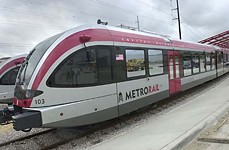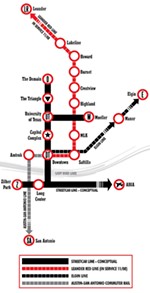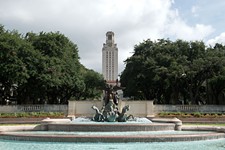Rail Revival?
Proposed Austin-San Antonio rail line could take commuters all the way from Georgetown to downtown San Antonio on a Union Pacific freight corridor with 15 stops
By Kimberly Reeves, Fri., Dec. 30, 2005
The local Leander line pales in comparison to the proposed Austin-San Antonio rail line, which could take commuters all the way from Georgetown to downtown San Antonio on a Union Pacific freight corridor with 15 stops. Such a rail line, unlike Capital Metro's venture, does not require a vote of the people and could be funded entirely as a public-private partnership between the rail district and developers around the rail stations. The estimated cost of the venture is 10 times that of Capital Metro's rail line: $615 million to both secure the line and provide initial operating expenditures.
The creation of the Austin-San Antonio line is a tricky task. This is the line that would require Union Pacific to vacate its freight rail line down MoPac and shift freight traffic over to the SH 130 corridor. Sid Covington, chair of the rail district board, told his members at a recent meeting that Union Pacific was open to negotiations and he was confident such a strategy could be achieved, possibly by 2010. Double-tracking within the freight rail's right of way also is an option on the table.
Once the train cars pass Austin on the Union Pacific line, they're on a track that goes through Buda, Kyle, and New Braunfels. At San Antonio, the rail line splits and the Austin-San Antonio rail corridor could pick up both a line past the airport into downtown San Antonio and an east-side route that board members support for its economic potential in an area of San Antonio that sorely needs redevelopment.
Two aspects of the project are currently on track. First is an updated feasibility study by Carter & Burgess, slated for completion next spring. An initial alternatives analysis, completed in 1999, is considered out-of-date. This alternatives analysis is a requirement of the federal New Starts program, an initiative of the Federal Transportation Administration that provides seed money for urban rail lines. Even the strongest backers of the Austin-San Antonio route, like rail district President Ross Milloy, agree the chances of federal funding are slim given the widespread competition for the limited dollars. A second federal funding program, targeted at creation of commuter rail lines in the Southwest, is another potential source of funding, Milloy said.
That leads to the second task at hand, an assessment of the potential economic impact around the 15 stations along the route. Consultant Charles Heimsath of Capitol Market Research is completing that study, looking at each station individually for its development potential. If local jurisdictions agree, tax-increment finance districts around each station could capture incremental increases in value to fund the creation and operation of the rail line. Or the rail district could, as board member Fred Harless pointed out, buy up undeveloped land around the various stations and hammer out agreements with developers to share the cost of the rail line in exchange for access to station land. That's a strategy that Capital Metro has used to defray the cost of its line.
Heimsath's early economic impact figures, based on a dozen stations, project a potential $353 million in tax dollars over 25 years, which bodes well for the rail district. Heimsath's full report should be available some time early next year.
Got something to say on the subject? Send a letter to the editor.











